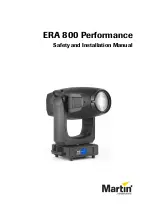
- 15 -
17. Troubleshooting Guide
Trouble
Potential Reasons
How to Fix
Cannot calibrate
Incorrect calibration
order
Power on the tester, calibrate pH 7 first, then pH 4. After pH 4 is
calibrated, if you want to calibrate pH 7 again, you need to reboot
the tester.
Poor quality
standard solutions
Replace with fresh and clean standard calibration solutions made
by legitimate scientific instrument manufacturers.
Contaminated probe Clean the probe with Apera’s cleaning solution or detergent water.
Aged probe
Replace the probe.
Dried-out probe
Soak the probe in the 3M KCL soaking solution for at least 15
minutes.
Probe is not fully
submerged in the
solution
Make sure the probe is fully immersed in the solution at least 1 inch
deep.
Air bubbles around
the sensor
Make a quick stir in the solution to remove air bubbles.
Reading is
always slowly
changing, won’t
stabilize.
Contaminated probe Clean the probe with Apera’s cleaning solution or detergent water.
Clogged junction
Clean the probe with Apera’s cleaning solution, then soak it in 3M
KCL soaking solution overnight.
Aged probe
Replace the probe.
Testing pH of low
iconic strength
solutions like tap
water, drinking
water, RO water
Be patient, wait for 1-5 minutes to reach a fully stabilized reading. If
still not stabilizing, add 1ml of Apera 3M KCL solution to 1000ml of
test solution (or 1 teaspoon to 1 gallon).
Display similar
readings in any
solutions or
always display
7.0 pH
Broken probe
If you don’t find any visible damage of the probe and it’s within the
1-year probe warranty, contact your point of purchase for warranty
fulfillment;
If there is visible damage or the probe is more than 1-year old,
replace the probe.
Reading keeps
jumping
Probe is not fully
submerged in the
solution
Make sure the probe is fully immersed in the solution at least 1 inch
deep.
Air bubbles around
the sensor
Make a quick stir in the solution to remove air bubbles.
Probe is not properly
connected or the pin
connector is broken.
Check the probe’s connector, make sure it’s not broken and is
correctly connected. Align the probe and instrument correctly
before plugging in. Never force it.
Ensure that the probe connector is not exposed in the air too long.
Calibration is
successful, but
reading is not
accurate
Aged probe
Replace the probe.
Air bubbles around
the sensor
Make a quick stir in the solution to remove air bubbles.
Clogged junction
Clean the probe with cleaning solution, then soak it in 3M KCL
soaking solution overnight
Comparison with
other testers, test
strips, or drop tests
To compare with other testers, make sure to perform a 2-point
calibration for all testers in the same standards, then test a 3rd
point. Whichever gives more accurate reading in the 3rd point
standard is the more accurate one.
Test strips or drop tests’ accuracy is not comparable to pH meters’.


































